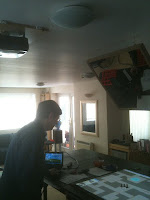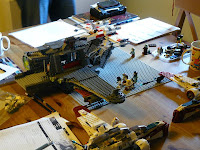 |
| Click to Zoom |
Ok so you have a huge collection of miniatures, they're painted and based and look fantastic. But that's only half the story, what are you going to use to represent the world they are moving around in? Being able to see where each character is in relation to the others is a huge tactical advantage and can really help everyone become immersed in a game but if no one can tell where the walls in a dungeon are you aren't going to get very far.
Well luckily there are a wide variety of solutions for you, ranging from the incredibly cool but expensive to the function but cheap, I thought i'd share my views on some of those solutions and share some that my friends have come up with.
1. Resin Terrain.
 |
| Click to Zoom |
 |
| Click to Zoom |
For me Dwarven Forge is the terrain I would use if I had a big budget, it looks fantastic but isn't for those on a budget.
2. Using a Computer Monitor or Virtual Tabletop
 |
| Click to Zoom |
 |
| Click to Zoom |
This is a mapping solution one of my friends used with very impressive results. Its technically challenging and could be quite expensive but most Roleplayers own a computer so the monitor/HDTV is the real cost.
There are various free or inexpensive computer programs that will help you create floor plans and maps for your miniatures to adventure in and the big advantage I see is that the Gamesmaster can restrict what his or her players can see to what their characters can.
An alternative is to use a projector with an overhead mirror (see above right) to transfer the image directly to a normal tabletop. However projectors aren't cheap either so it might not be the best solution unless you already have access to one.
3. Really Creative!
 |
| Click to Zoom |
 |
| Click to Zoom |
The same friend who worked with the Virtual Tabletop idea also came up with a very creative solution. Lego! His Star Wars game was brought to miniature life by using the rather excellent Star Wars Lego collection and building the scenes accordingly.
I imagine his players had a great time building their miniatures and that he enjoyed building the sets just as much. While i'm not sure Lego would be the right terrain choice for a Fantasy game it really works for Star Wars. From the photos you can see the level of effort he achieved and i'm sure his players had a blast.
4. Battlemats, Floor tiles and Card Scenery
 |
| Click to Zoom |
 |
| Click to Zoom |
We tend to use card stock floor tiles cut into common lengths which are laminated and put together to create the dungeons. The advantages are that they are cheap, once you've built up a small collection you can build most dungeons easily and as they are laminated you can draw on them with dry wipe markers during combat. We also add a few 3D items like doors, tables and treasure chests from the old Heroquest game.
I've found that the free download sets from the Dungeoneering.net site are a great start and the Dungeons & Dragons Floor Tiles packs are still available at reasonable prices. If you add a few 3D pieces of scenery to these sets you can get a decent result.
 |
| Click to Zoom |
 |
| Click to Zoom |
In fact the Wild West set has me very tempted to paint some cowboys!
One thing in the vein of Dwarven Forge, is the Hirts Art's Castlemolds. The downside is the cost and time needed to make dungeons, but advantage is the flexibility to make what you need.
ReplyDeletehttp://www.hirstarts.com/
Hirst Arts is great if you can afford some molds and the resin, because you can cast as many parts as you like. They need to be painted though, so you'll want to be ready to paint lots of scenery. Simple black basecoat with several dark to lighter grey drybrush layers will do.
ReplyDeleteI personally use the HeroQuest board, and boards from other fantasy games, such as Dragon Strike (4 nice boards), D&D boardgame (the classic one with square tiles) and even some maps from magazines which I printed and glued to cardboard.
I also own Advanced HQ, which has modular tiles.
There was a kickstarter some months ago that had prepainted Hirst Arts dungeon pieces (Itar's). I ordered a primed set in grey, so all I need to do is drybrush them lighter in greys and add some dark wash, and I'll have a nice 3D set!
I have been looking into dungeon terrain options for my Heroquest games, and ran into the same problem with resin terrain (it's too expensive). On the other hand, I find battlemats or card scenery too shiny and fake looking.
ReplyDeleteSo I finally found out about Styrofoam. Blue (usually) styrofoam can be cut into any shape quite easily, and unlike the white styrofoam that is often used in packaging, does not consist of little foam balls that tear apart awkwardly when you cut them. It is also a light and fairly durable material. I think I will use this to build my dungeon rooms. You can buy it at most hobby shops.
Simply cut out squares or whatever shape of room you want, then make a grid of tiles on the floor of the room with a knife and a ruler. Prime the entire thing black, then softly drybrush dark grey or another stone-like color over it. I think it will look pretty decent.
If you want to go all the way with this technique, you could even cut out lots of tiny bricks from the styrofoam and build walls around each room you build. Again I would prime the bricks black, then glue them together as a wall, then softly drybrush with grey.
Hope this advice is useful to anyone.
I love how creative people are getting with representing their gaming worlds.
ReplyDelete